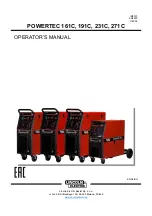
17
Detailed Performance Data for the TML 500 F
Values shown for load capacity of the TML 500 F are based on material S235 JR for the maximum, vertical tractive
force with 0° deviation from the load axis including a 3:1 safety factor. This manual does not contain any instructions
for use on round material, as the TML 500 F is designed for flat material and round material or arched objects may
not be lifted.
Table 2
Load capacity in kg
Thickness of
material
Clean, flat, ground
surface
Rusty, slightly scratched
surface
Irregular, rusty or rough
surface
Air gap <0.1 mm
Air gap = 0.25 mm
Air gap = 0.5 mm
mm
0°
0°
0°
2
50
45
40
3
130
115
85
4
195
160
135
5
300
240
190
6
360
270
220
8
455
310
240
10
490
360
245
15
500
365
250
>20
500
370
250
Load capacity in lbs
Thickness of
material
Clean, flat, ground
surface
Rusty, slightly scratched
surface
Irregular, rusty or rough
surface
Air gap <0.004 inches
Air gap = 0.01 inches
Air gap = 0.02 inches
inch
0°
0°
0°
0,08
110
100
90
0,12
285
255
185
0,16
430
355
295
0,20
660
525
415
0,25
800
595
480
0,30
1000
685
525
0,40
1090
785
540
0,50
1100
800
545
>1
1100
815
555
The maximum dimensions of the loads to be lifted depend to a large extent on the geometry and flexural stiffness of
the work pieces. If the material bends, an air gap will form under the magnetic surface which will decrease the load-
bearing capacity significantly.
During each lift, watch for any deformation of the work piece that might occur and check for any air gap developing
at the edges of the magnetic surface contact area. You can use for instance a sheet of paper (80g/m
2
) to check this.
Spreader bars with additional magnets may be required to safely lift large or flexible loads.
Immediately stop the lift if there is any excessive deformation of the work piece or an air gap.
Never exceed load-bearing capacity given in the table 2.
Содержание TML 500 F
Страница 28: ...28 ...
Страница 29: ...29 07 2017 ...













































